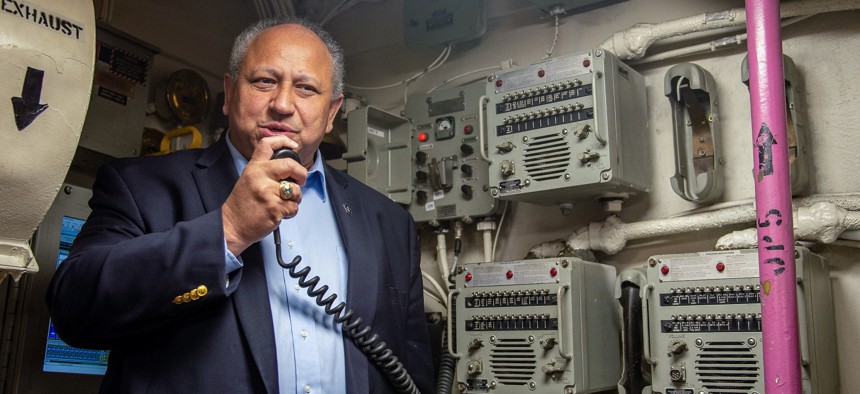
Secretary of the Navy Carlos Del Toro addresses the crew over the 1MC aboard the Nimitz-class aircraft carrier USS Harry S. Truman, Nov. 25, 2021. U.S. Navy / Mass Communication Specialist Seaman T'ara Tripp
The Navy Remains Stuck At the Pier Without a Leadership Team
Three of the service’s top jobs are filled by temps, nearly 11 months into the Biden administration.
A new administration’s picks for key leadership positions—and when it picks them—give an early indication of its policy priorities. By that measure, the number of key leadership positions in the U.S. Navy still unfilled suggests that the Biden administration finds an inadequate fleet size, an unexecuted maritime strategy, and a crumbling infrastructure in the nation’s sea service to be acceptable.
You may recall that, by spring of 2017, a loud chorus of pundits and press had proclaimed the Trump administration’s lack of nominees to be a national security crisis. Well, the Biden team is now approaching winter, and judging by past standards, the naval leadership team remains critically short of players.
Still unnamed are nominees to be Navy undersecretary, deputy undersecretary for strategy and policy, and assistant secretary for research and acquisition. With today’s Navy under increased maritime threat from China and Russia, this is no time for the sea service to be on autopilot or shunted to the back of the policy debate room.
Given the speed with which other service secretaries were named, the administration’s low priority for the Navy is puzzling. Only after President Biden had tapped nominees to lead the Army and Air Force in late April did Carlos Del Toro’s name surface as a likely candidate. It took two more months, amid increasing bipartisan Congressional pressure, before his nomination was formally announced. Del Toro’s confirmation hearing was expedited and he was finally confirmed as secretary on Aug. 9, 73 days after the President submitted his budget for fiscal year 2022.
It's worth noting that a short-lived controversy broke in June when a Navy budget memo was leaked to the press. The memo revealed that, contrary to earlier understandings with Congress, then-acting Secretary Thomas Harker was cutting programs and setting priorities that would further shrink the fleet. This fiasco probably helped fast-track Del Toro’s confirmation.
Yet four months into the job, Del Toro still has been unable to get important positions filled—or even nominees identified, for that matter. As tensions rise in Asia and Eastern Europe and the Biden administration contemplates responses, the Navy’s senior political positions are being managed by temps.
The Navy undersecretary typically is the lead civilian responsible for fulfilling the Navy’s secretary’s vision. But an unconfirmed temp fills this role, effectively neutering the Navy’s ability to effect decisive change. And decisive change is desperately needed now. In just the past month, the damning results of an investigation into the loss of the Bonhomme Richard have been released, the nuclear attack submarine Connecticut had limped to Guam then onto Bremerton where it awaits emergency repairs after running into an undersea mountain, and the Navy’s shipbuilders and shipyards are beginning to be affected by the current national logistics snafu.
The lead civilian official in the Navy responsible for strategy and policy is also a temp. This gives the service no working-level political voice in policy debates on relationships with key naval allies. Those discussions are critical, given mounting tensions with China and Russia. The Navy deputy undersecretary also should play an important role coordinating intelligence activities, strategically significant operations, and drive naval engagement with allies and partners—such as Ukraine and Taiwan—that are under severe military stress.
When it comes to shipbuilding and addressing the enduring shipyard capacity issues confronting the Navy, the role of assistant Navy secretary for research, development, and acquisition stands out. Yet another temporary officeholder, Frederick J. Stafany, has been filling this key position since the capable Hondo Geurts left the job on Jan. 20.
During Stefany’s conservatorship, the Navy released an updated long-range shipbuilding plan, which can only be viewed as an interim document until the permanent office-holders are appointed and gain their sea-legs.
It’s worth noting the president’s current budget proposal was compiled without the benefit of a political voice from the Navy. Thankfully, that budget is about to be overruled. Had a Navy secretary been in place in February, perhaps Congress would not have had to add back into the budget monies honoring past commitments to build large amphibious warships, adding in a destroyer and cutting back on plans to decommission seven cruisers.
The Navy’s next fiscal budget is already being planned, but without the benefit of a full team to champion the fleet’s needs within the Pentagon and with Congress. In his first message to the fleet on Aug. 10, Secretary Del Toro stressed the risk from China. On Nov. 4, he called for sustained naval shipbuilding budgets three to five percent above inflation. While this is likely not enough to pace the threats before us, it is certainly a promising sign.
That said, until the Secretary has a full team on board, it is unlikely the Navy will be able to advocate effectively for the maritime policies and resources needed to slow or counter China’s rapid military expansion. It is time for Congress to pressure the administration to fill these critical jobs at the Navy.
Brent D. Sadler is the senior fellow for naval warfare and advanced technology at The Heritage Foundation’s Center for National Defense.




